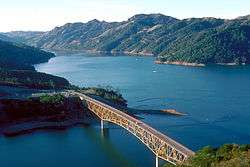Lake Sonoma
Lake Sonoma is a reservoir west of Cloverdale in northern Sonoma County, California, created by the construction of Warm Springs Dam. Access from U.S. Route 101 is by way of Canyon Road (from the south) from Geyserville, or Dutcher Creek Road (from the north) from Cloverdale.
| Lake Sonoma | |
|---|---|
 The lake, just behind the Warm Springs Dam, which is to the right of this view | |
 | |
| Location | Sonoma County, California |
| Coordinates | 38°43′05″N 123°00′34″W |
| Lake type | reservoir |
| Primary inflows | Dry Creek |
| Primary outflows | Dry Creek[1] |
| Catchment area | 130 sq mi (340 km2)[2] |
| Basin countries | United States |
| Max. length | 5.7 mi (9 km)[1] |
| Surface area | 2,700 acres (1,100 ha)[3] |
| Water volume | 381,000 acre⋅ft (0.470 km3)[2] |
| Shore length1 | 50 miles (80 km)[3] |
| Surface elevation | 200 feet (61 m)[1] |
| 1 Shore length is not a well-defined measure. | |
The lake provides water for countywide growth and development, and for recreation. At full capacity, it has 50 miles (80 km) of shoreline, a surface area of more than 2,700 acres (11 km2),[3] and holds 381,000 acre feet (470,000,000 m3) of water.[2] Activities include boating, swimming, fishing, riding, hiking, camping, and hunting.[3] Notable features include the Milt Brandt Visitor Center, the adjacent Congressman Don Clausen Fish Hatchery, and the Warm Springs Recreation Area below the dam.
The US Army Corps of Engineers built Warm Springs Dam across Dry Creek. Completed in 1982, this rolled-earth embankment dam is 319 ft (97 m) high, 3,000 ft (900 m) long, and 30 ft (9 m) wide at the top. It contains 30,000,000 cu yd (23,000,000 m3) of earth.[2] The dam aids in flood control, and a hydroelectric plant produces electricity from the water released downstream. A minimum amount of flow must be maintained in Dry Creek to allow fish migration.
Pomo people had lived in the Dry Creek area since at least the 18th century, and some of them resisted the creation of the lake. Archaeologists at Sonoma State University have written about the prehistory and history of Warm Springs Dam, Lake Sonoma, and the Dry Creek Valley.[4]

The California Office of Environmental Health Hazard Assessment (OEHHA) has developed a safe eating advisory for Lake Sonoma based on levels of mercury or PCBs found in fish caught from this water body.[5]
See also
- Dry Creek Valley AVA
- Lake Mendocino
- List of dams and reservoirs in California
- List of lakes in California
- List of lakes in the San Francisco Bay Area
- List of largest reservoirs of California
References
- U.S. Geological Survey Geographic Names Information System: Lake Sonoma
- "Dams Owned and Operated by Federal Agencies" (PDF). Retrieved January 4, 2008.
- "Lake Sonoma: Welcome". U.S. Army Corps of Engineers.
- "Before Warm Springs Dam". Sonoma State University Anthropological Studies Center.
- Admin, OEHHA (December 30, 2014). "Lake Sonoma". OEHHA. Retrieved June 13, 2018.
External links

- news article about annual inspection of Warm Springs Dam